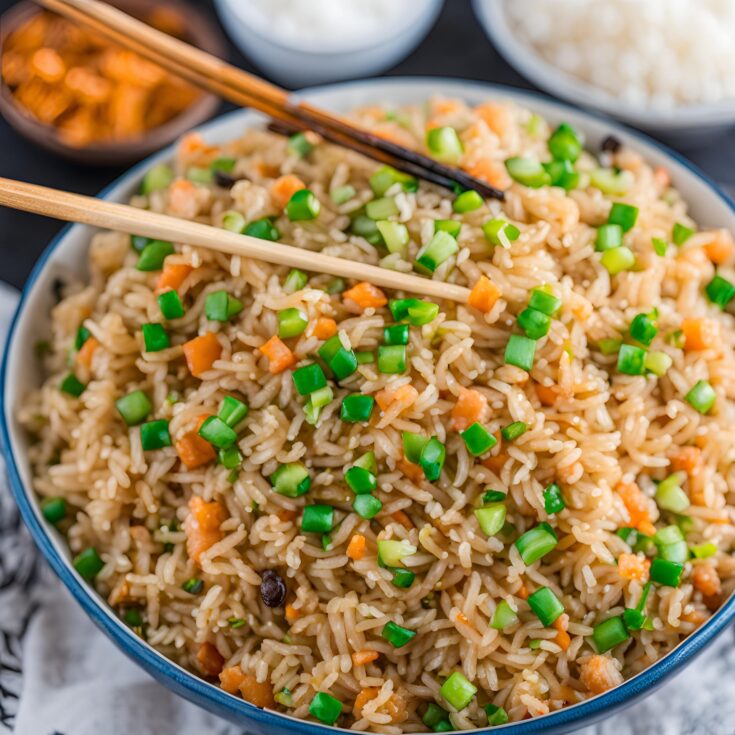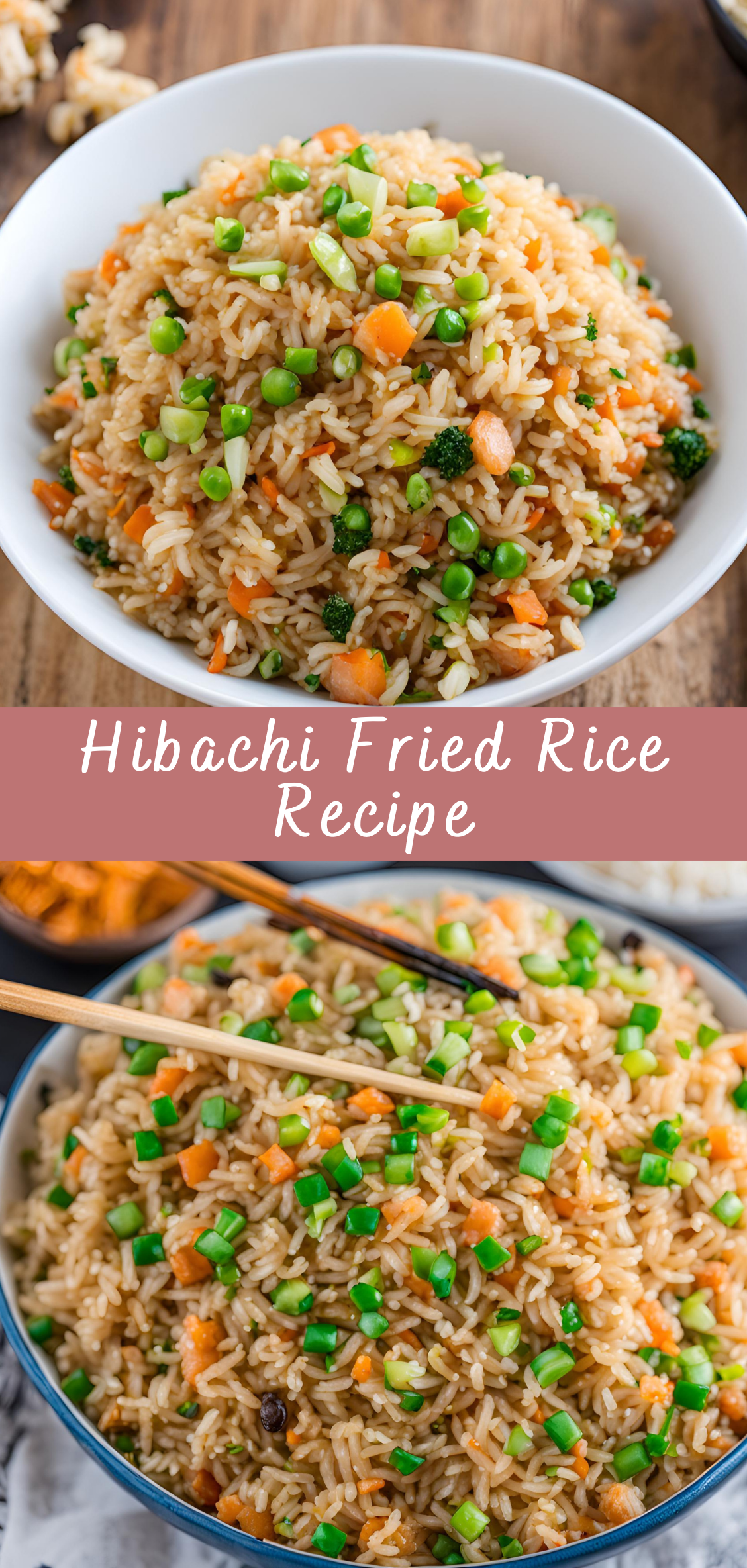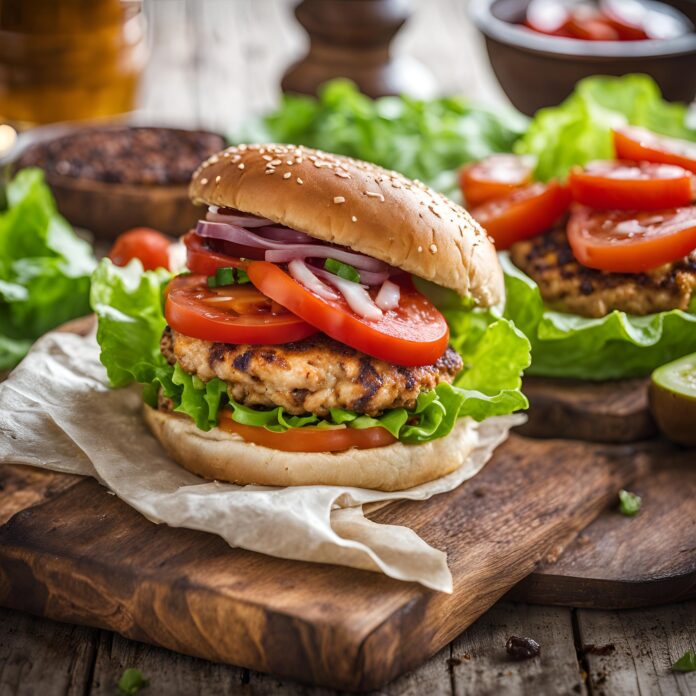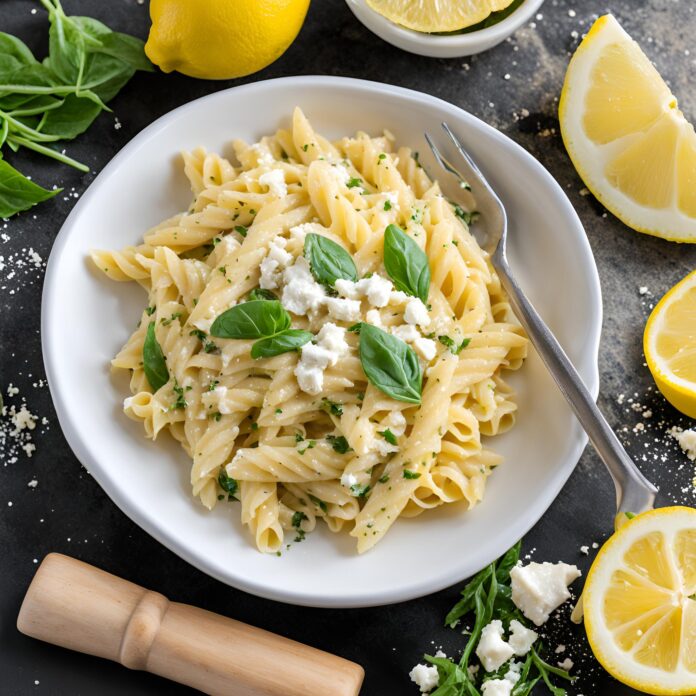Hibachi Fried Rice Recipe
Hibachi fried rice is a popular and flavorful dish served in many Japanese steakhouses. The term “hibachi” refers to a traditional Japanese grilling method, but when it comes to hibachi-style fried rice, the term is often used to describe the flavorful, stir-fried rice cooked with vegetables, eggs, and soy sauce, much like the type of fried rice you’d find at teppanyaki restaurants. The dish is iconic for its quick cooking method and delicious, savory flavor.

Hibachi fried rice is typically prepared using day-old rice because it fries better and holds up to the high heat of the grill or pan. The signature flavors come from soy sauce, garlic, onion, and butter, giving it richness and depth. A combination of scrambled eggs, peas, and carrots is often included, along with a finishing touch of green onions and sometimes a sprinkle of sesame seeds.
The beauty of hibachi fried rice is its versatility. You can customize it with different proteins like chicken, shrimp, or beef, or even make it vegetarian. The key is to get the rice crispy and infused with all the rich flavors while keeping the ingredients fresh and balanced.
In this recipe, we’ll go through the step-by-step process of making authentic hibachi fried rice at home, from choosing the right ingredients to cooking and serving. This will be an in-depth guide that will cover the history, ingredients, instructions, tips, and even some variations for your hibachi fried rice.
Instructions for Making Hibachi Fried Rice
Now that we’ve gathered all the ingredients, it’s time to walk through the steps of cooking hibachi fried rice. The cooking process is fast and requires a hot pan or wok, so have all your ingredients ready to go.
Step 1: Prepare the Rice
- Use Day-Old Rice: Start with day-old rice for the best texture. If you don’t have leftover rice, you can cook fresh rice and let it cool in the fridge for at least an hour to dry out slightly. The key to fried rice is that the rice grains should be separate and not sticky.
Step 2: Cook the Proteins (Optional)
If you are adding chicken, shrimp, or beef to your hibachi fried rice:
- Chicken: Season the chicken with a pinch of salt, pepper, and a splash of soy sauce. Cook the chicken in a separate pan until browned and cooked through, about 5-7 minutes. Once cooked, remove from the pan, chop into small pieces, and set aside.
- Shrimp: If you are using shrimp, season with a pinch of salt and pepper, and cook in a hot pan with some oil until the shrimp turns pink and opaque, about 2-3 minutes per side. Remove from the pan and set aside.
- Beef: For steak, slice the beef thinly against the grain and cook it quickly in the pan for 2-3 minutes until browned and cooked through. Set aside.
Step 3: Scramble the Eggs
- In the same pan or wok, add a bit of oil and scramble the eggs. Once they’re just set, remove them from the pan and set aside. Don’t overcook the eggs, as they’ll continue cooking when you add them back to the rice.
Step 4: Stir-Fry the Veggies
- In the same pan, add butter and vegetable oil. Let the butter melt over medium-high heat.
- Add the minced garlic and onion to the pan. Sauté for about 2 minutes until fragrant and the onions are translucent.
- Add the diced carrots and peas to the pan. Stir-fry for about 3 minutes until they are cooked through and softened. If the vegetables start to stick, add a little extra oil.
Step 5: Add the Rice
- Add the day-old rice to the pan or wok. Break up any clumps with a spatula. Stir-fry for about 5 minutes, allowing the rice to crisp up a bit. This is the key to getting that signature texture in hibachi fried rice.
Step 6: Season the Rice
- Drizzle the rice with soy sauce, and add sesame oil, salt, and pepper to taste. Stir everything together, ensuring that the rice is evenly coated with the seasonings.
Step 7: Combine Everything
- Add the scrambled eggs, cooked chicken, shrimp, or beef (if using) back into the rice. Stir to combine everything evenly.
- Toss in the chopped green onions for added freshness.
Step 8: Serve and Garnish
- Serve the hibachi fried rice immediately, garnished with additional green onions or sesame seeds. You can also drizzle a little more soy sauce over the top if desired.
Tips for Perfect Hibachi Fried Rice
- Use Day-Old Rice: Fresh rice is too moist and sticky for stir-frying. If you don’t have day-old rice, make sure the rice cools down before frying.
- High Heat: Hibachi fried rice is cooked on high heat, so ensure your pan or wok is very hot before adding the rice. This will allow it to fry properly and give it the crispy texture.
- Prep Ahead: Since hibachi fried rice cooks quickly, it’s essential to have all your ingredients prepped and ready before you start cooking. This includes chopping the vegetables, beating the eggs, and having the rice on standby.
- Customize the Protein: Hibachi fried rice is versatile—feel free to add your choice of protein. Shrimp, beef, or chicken are all great options, but you can also make a vegetarian version by simply skipping the protein and adding extra veggies.
- Add Butter for Richness: Butter adds richness to the fried rice, but don’t skip it! You can also use a little bit of garlic butter for even more flavor.
Variations
- Vegetarian Hibachi Fried Rice: Skip the meat and add extra vegetables like broccoli, mushrooms, or bell peppers. You can also add tofu for added protein.
- Hibachi Fried Rice with Pineapple: Add some pineapple chunks to the fried rice for a sweet contrast to the savory flavors. This pairs especially well with shrimp.
- Spicy Hibachi Fried Rice: Add a few dashes of sriracha or chili paste to the rice while cooking to give it a spicy kick.
Additional Variations for Hibachi Fried Rice
Hibachi fried rice is highly adaptable, and you can modify it to suit different dietary preferences, flavors, or even the ingredients you have on hand. Here are more variations and ideas to make your hibachi fried rice even more exciting and personalized.
1. Hibachi Fried Rice with Teriyaki Sauce
If you enjoy the sweet and savory flavor of teriyaki sauce, you can drizzle a small amount over your rice towards the end of cooking. This adds a rich, slightly sweet flavor that pairs perfectly with the savory components of the dish. Use low-sodium teriyaki sauce for a healthier option, and balance the sweetness with a splash of soy sauce if necessary.
2. Spicy Hibachi Fried Rice with Chili Paste or Sriracha
For those who love a little heat, adding chili paste, sriracha, or gochujang (Korean chili paste) can elevate your fried rice with a spicy kick. You can stir in the chili paste during the cooking process or use it as a topping for added flavor. To make it extra spicy, top the fried rice with red pepper flakes or even a sprinkle of fresh chopped jalapeños.
3. Hibachi Fried Rice with Bacon or Ham
For a smoky twist, add some bacon or ham. Bacon pieces add a salty, crispy crunch that complements the soft rice and vegetables. If using bacon, cook it first, then use the rendered fat to cook the vegetables. Ham is a fantastic alternative, adding a slightly sweet and savory flavor to the fried rice.
4. Hibachi Fried Rice with Mushrooms
Mushrooms add an earthy, umami flavor to hibachi fried rice. You can use shiitake, cremini, or button mushrooms, sautéing them until golden before adding them to the rice. Mushrooms pair especially well with beef or chicken as the main protein.
5. Vegetarian Hibachi Fried Rice with Tofu
To make your hibachi fried rice vegetarian, substitute the meat with tofu. Use firm tofu, press out excess moisture, then cut it into small cubes and pan-fry it to crispy perfection before adding it to the rice. This version adds a plant-based protein, while maintaining a deliciously savory flavor.
6. Hibachi Fried Rice with Avocado
For an extra creamy texture and fresh flavor, consider adding sliced avocado on top of the fried rice just before serving. The mild, buttery taste of avocado balances the savory and spicy notes of the dish, making it a great finishing touch.
How to Make Hibachi Fried Rice Healthier
If you’re looking to make your hibachi fried rice a bit healthier without sacrificing flavor, there are a few swaps you can make:
1. Use Brown Rice or Quinoa
Instead of traditional white rice, you can substitute brown rice for a higher fiber content. If you’re looking for a gluten-free option, quinoa makes a great substitute for rice and adds more protein.
2. Reduce the Oil
You can use less oil while cooking the rice, or even swap it for a non-stick spray to cut down on calories. The butter can also be reduced or replaced with a small amount of olive oil or avocado oil for a heart-healthier option.
3. Add More Veggies
Increase the nutritional value of your hibachi fried rice by adding extra vegetables like spinach, broccoli, zucchini, snow peas, or bell peppers. These vegetables will add fiber, vitamins, and minerals to the dish without compromising the flavor.
4. Use Low-Sodium Soy Sauce
Soy sauce is an essential ingredient in hibachi fried rice, but it can be quite salty. Opt for low-sodium soy sauce or tamari (for gluten-free) to cut down on sodium without sacrificing the delicious flavor.
Cooking Tips for Hibachi Fried Rice
To ensure that your hibachi fried rice turns out perfectly every time, follow these helpful tips:
1. Use a Wok or Large Pan
A wok is the ideal cooking vessel for hibachi fried rice because its wide surface area allows the rice to fry evenly. If you don’t have a wok, a large, high-sided skillet will also work. The key is to have enough space for the rice to spread out and crisp up without overcrowding.
2. Work Quickly
Hibachi fried rice cooks quickly over high heat, so it’s important to have all of your ingredients prepped and ready to go before you start. This includes chopping vegetables, beating eggs, and having your rice at room temperature or slightly chilled.
3. Stir-Fry in Batches
If you’re making a large batch of fried rice, it’s often best to cook it in batches. Overcrowding the pan can cause the rice to steam rather than fry, leading to less crispy rice. By cooking the rice in smaller batches, you ensure that each grain gets the necessary contact with the hot pan.
4. Use Cold Rice
Cold, day-old rice is the best for fried rice because it is drier, which makes it less likely to clump together and ensures it fries nicely. If you don’t have day-old rice, spread fresh-cooked rice on a baking sheet and let it cool in the refrigerator for about 30 minutes.
5. Control the Heat
Keep the heat on medium-high to high throughout the cooking process. If the heat is too low, the rice will cook slowly and may become soggy. If the heat is too high, you risk burning the rice. Aim for a balance of high heat with quick stirring.
6. Don’t Overcrowd the Pan
If you’re adding protein or vegetables to the fried rice, be sure not to overcrowd the pan. This will allow everything to cook evenly and help the rice stay crispy rather than turning mushy.
Serving and Pairing Suggestions
Hibachi fried rice is a satisfying dish on its own, but it also pairs well with a variety of sides and beverages. Here are a few suggestions to complete your meal:
Sides:
- Grilled Vegetables: Grilled or roasted vegetables like asparagus, bell peppers, or zucchini pair perfectly with hibachi fried rice. These light, fresh vegetables complement the richness of the rice.
- Miso Soup: A traditional Japanese miso soup with tofu and seaweed is a great starter to accompany your hibachi fried rice.
- Japanese Pickles (Tsukemono): These tangy pickles provide a nice contrast to the savory flavors of the fried rice and add a refreshing crunch.
Beverages:
- Iced Green Tea: The refreshing and slightly earthy taste of iced green tea complements the umami flavors of hibachi fried rice.
- Sake: If you’re looking for an alcoholic beverage, sake (Japanese rice wine) pairs wonderfully with hibachi-style dishes.
- Japanese Beer: For a casual and refreshing pairing, try a Japanese beer like Asahi, Sapporo, or Kirin.
Conclusion
Making Hibachi Fried Rice at home is a fun and rewarding experience that brings the flavors of a Japanese steakhouse right to your kitchen. Whether you’re cooking for a crowd or just a quick weeknight meal, this recipe is customizable, flavorful, and easy to make. By following the steps above and using high-quality ingredients, you can create an authentic hibachi-style fried rice that rivals any restaurant.
With endless possibilities for customization and variations, hibachi fried rice can be tailored to suit your tastes, making it the perfect dish for any occasion. Enjoy this delicious, savory rice dish with family and friends—everyone will love the rich flavors and satisfying texture!
Hibachi Fried Rice is a versatile, flavorful, and satisfying dish that brings the essence of Japanese cooking into your kitchen. Whether you’re preparing it as a side or a main dish, it’s a meal that can be easily customized to suit your tastes and dietary preferences. With the right ingredients, cooking techniques, and a little creativity, you can enjoy authentic hibachi fried rice at home, replicating the taste of your favorite hibachi grill restaurant.
From protein options to veggie variations and seasoning tips, you now have all the knowledge to make this dish your own. Whether you’re serving it with a side of grilled shrimp, a heaping portion of beef, or keeping it vegetarian with extra veggies and tofu, hibachi fried rice is sure to be a crowd-pleaser.
Enjoy the process, and happy cooking!
Hibachi Fried Rice Recipe

Hibachi fried rice is a popular and flavorful dish served in many Japanese steakhouses. The term "hibachi" refers to a traditional Japanese grilling method, but when it comes to hibachi-style fried rice, the term is often used to describe the flavorful, stir-fried rice cooked with vegetables, eggs, and soy sauce, much like the type of fried rice you'd find at teppanyaki restaurants. The dish is iconic for its quick cooking method and delicious, savory flavor.
Ingredients
- 3 cups cooked white rice (preferably day-old rice for best texture)
- 2 tablespoons vegetable oil (or sesame oil for extra flavor)
- 2 eggs, lightly beaten
- 1/2 cup diced onion
- 1/2 cup diced carrots
- 1/2 cup frozen peas (thawed)
- 2-3 cloves garlic, minced
- 3 tablespoons soy sauce (or tamari for gluten-free)
- 1 tablespoon oyster sauce (optional)
- 1 tablespoon sesame oil (optional)
- 1/4 teaspoon ground black pepper
- 2 green onions, sliced (for garnish)
- Optional: cooked shrimp, chicken, or steak (for a protein addition)
Instructions
- Prepare the rice: If using freshly cooked rice, spread it out on a baking sheet to cool for a few minutes to remove excess moisture. Day-old rice works best for fried rice because it’s drier and less sticky.
- Cook the eggs: In a large skillet or wok, heat 1 tablespoon of vegetable oil over medium heat. Add the beaten eggs and scramble until fully cooked, then remove from the pan and set aside.
- Cook the vegetables: In the same pan, add another tablespoon of vegetable oil. Add the diced onion and carrots. Sauté for 3-4 minutes until the vegetables are tender. Add the garlic and peas and cook for another minute.
- Add the rice: Add the cooked rice to the pan, breaking up any clumps. Stir-fry for 2-3 minutes until the rice is heated through.
- Season: Add the soy sauce, optional oyster sauce, sesame oil, and black pepper. Stir to combine, making sure the rice is evenly coated with the sauces.
- Finish: Add the cooked eggs back into the pan, stirring them into the rice. Cook for another 1-2 minutes to incorporate everything.
- Serve: Garnish with sliced green onions and serve immediately. Optionally, add cooked shrimp, chicken, or steak for extra protein.
Notes
- Use Day-Old Rice:
Fresh rice tends to be too moist and sticky for fried rice. For best results, use cold, day-old rice. If you don’t have leftover rice, you can cook fresh rice and let it cool in the fridge for at least 30 minutes to dry it out before frying. - High Heat:
Hibachi fried rice is cooked quickly on high heat. This helps to crisp up the rice and creates a delicious sear. Make sure your pan or wok is hot before adding the rice. - Avoid Overcrowding the Pan:
To get the perfect fried rice, avoid overcrowding the pan or wok. If you’re making a larger batch, cook the rice in batches to ensure even frying and prevent the rice from steaming rather than frying. - Customize the Protein:
Hibachi fried rice is versatile, and you can easily customize the protein based on your preference. Use chicken, shrimp, beef, or even tofu for a vegetarian version. Adjust the cooking time accordingly depending on the protein. - Use a Wok:
A wok is ideal for hibachi fried rice due to its high, sloping sides, which help the rice fry evenly and keep it from spilling over. If you don’t have a wok, a large skillet will work too. - Flavor Adjustments:
Feel free to adjust the amount of soy sauce, sesame oil, and butter based on your personal taste preferences. If you prefer a sweeter version, a dash of teriyaki sauce can be added at the end for extra flavor. - Add Veggies for Extra Nutrition:
Hibachi fried rice is a great dish to incorporate additional vegetables such as bell peppers, broccoli, or snow peas. These not only add more flavor but also increase the nutritional value of the dish.



